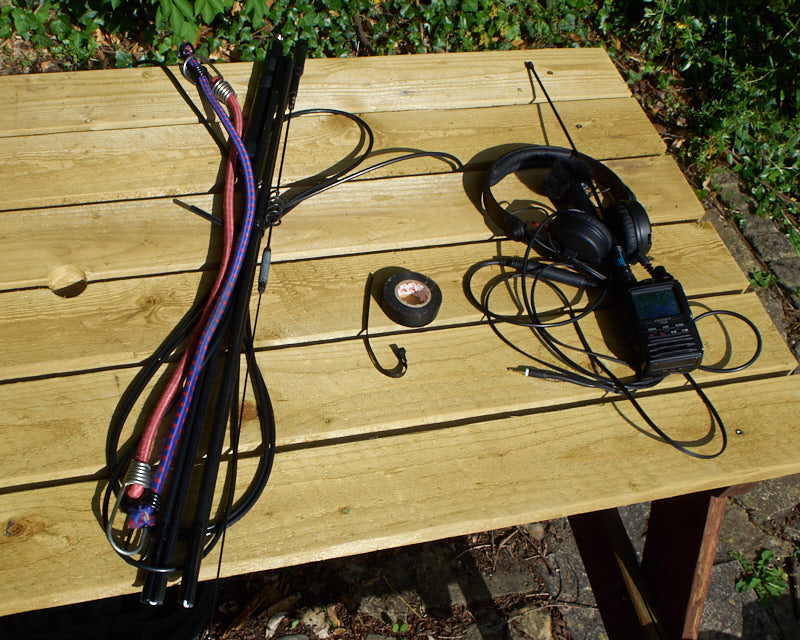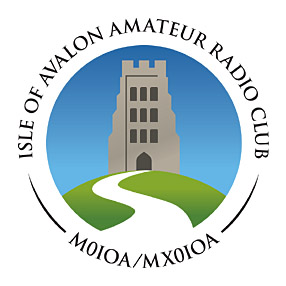SOTA Activation of Beacon Batch
Matt 2E0FNT and I decided to activate Beacon Batch G/SC003, travelling up to time things to match with the club 70cm net at 21:00 BST. The weather was fine, it was good to start the ascent later in the evening when things had cooled down a bit. We were treated to a bright Strawberry Moon on the return.

Self-training in the art of radio communication includes a fair amount of trial and error, and on this event I found trial and error ;) The star performer was Matt’s Anytone AT878 handheld with a foldable tactical antenna. This performed well 1, definitely best of everything we had between us.
Using 70cm means I couldn’t use my usual 2m flowerpot antenna, so I used an old Comet B20 mobile. This doesn’t require the car roof as a ground plane, I tested the SWR on 2m both directly connected to the SWR meter and on the end of the cable I was using for the exercise and it measured below 1.1 in the 145 MHz range. My SWR meter doesn’t extend to 70cm, but I confirmed this antenna still works on one of the design bands - works inasmuch as SWR was below 1.1 over the relevant part of the 2m band, though I wonder if it is more a tuned dummy load.

Although Beacon Batch is about 1km from the radio masts to the east of the site there were problems. Neither my FT3DE nor the old Kenwood TH-D7 performed well. The FT3DE is a typical modern handheld with a wide open front end, and showed a lot of activity without opening the squelch. G4ZDR reported2 that my second rig, a mid 1990s vintage Kenwood TH-D7 was 5kHz low in frequency as shown on his FT991A - the front-end of the old Kenwood was better but the QSO was marginal, probably because of this frequency error.
QRM from commercial sites is frustrating, because unlike inband QRM you don’t hear it specifically, it silently and intermittently deafens the receiver, one moment you hear the other side, the next it is all gone or gets scratchy.
I had read about handhelds having problems on SOTA summits due to the proximity of other radio services in the VHF and UHF bands, but hadn’t experienced the problem to this degree. I have done activations in Wales using an Anytone mobile rig and a LiFePo battery but not with a handheld. The antenna install using the B20, which can be seen attached to the trig point using bungee cord worked OK mechanically, and breaks down well.

But it was all to no avail, because the system didn’t work as a whole, because the handhelds weren’t up to the job. Matt’s rig uses a RP-SMA so I couldn’t connect the B20 to that. I did try the FT3DE with a rubber duck, which should attenuate the QRM, but it was still not capable of performing well enough.
It’s possible that the time of day also worked against us - in this comment Phil makes the observation
I find VHF FM with 5 watts and a vertical dipole will easily qualify you from North Wales, South Wales and most the NP, SP, LD and WB summits during the daytime. It won’t work in the evenings though once the Hams have had their dinners and then turned to the telly.
so there are a two takeaways:
- probably favour the daytime
- use something better than the FT3DE
Fixing the Kenwood TH-D7
The TH-D7 is old-skool, it has helical filters in the receive stages according to the block diagram. This may have a better SOTA potential than a more modern all-band rig, because the filtering might keep some out of band garbage out. But it’s off frequency.
Crystals tend to drift lower as they age3. The frequency error meant I had to complete the QSO with G4ZDR using Matt’s rig. There is a trimmer capacitor for X1, but the manual indicates this is good for a shift of ± 200Hz. I have seen the same pathology with PMR446 and CB rigs after the passage of many years. Since FM operation is channelised, the temptation is there to change the step size to 5kHz and program the 70cm channels with CHIRP setting the frequencies 5kHz high. It’s not a clean solution, but would get this back on frequency without risking the miniature surgery to adjust/change the crystal. The -2kHz offset on 2m is tolerable in a 12.5kHz channel, and the best option given setting the 2m channels +5kHz would end up 3kHz high.
However, the service manual did indicate the trimmer is easily accessible, and the -13ppm drift should be in the range of the trimmer. The TH-D7 is quite well designed for serviceability -
and the trimmer TC1 is easily to be seen at the right of the ribbon cable, labelled on the board. I had to grind down a trimmer tool and allow for the shift lower as it contacted the trimmer capacitor, but after the rig is reassembled it is now less than 200Hz high at 433.475MHz and less than 70Hz at 145.475MHz.
So overall a win. I bought the FT-3DE because this rig seemed to be getting deaf and low power output, but I think I now have the explanation for its substandard performance.
-
it suffered from some QRM, and one point receiving GB3WE on 145.475 MHz, but nowhere near the problems both G7LEE’s rigs had. ↩
-
I substantiated this at home as a centre frequency of 433.4695 MHz, when the display showed 433.475MHz. This would imply the PLL crystal has drifted low by ~13ppm, as a result of 30 years of ageing. It was 1.9kHz low on 145.525MHz in the 2m band. The reference crystal on both bands is a 12.8MHz crystal, according to the service manual ↩
-
IQD (in Crewkerne, Somerset) say “Generally the ageing effect is negative in over 90% of parts manufactured” ↩
